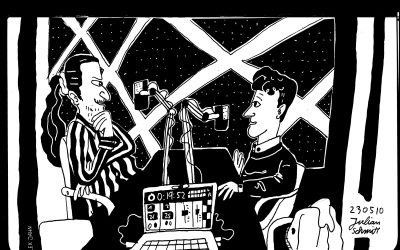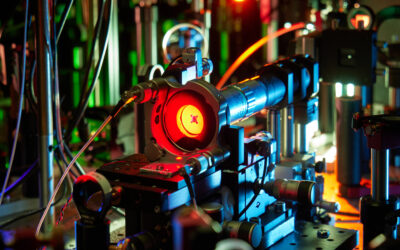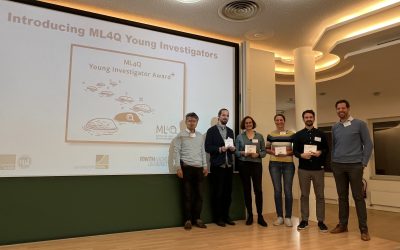Julian Schmitt looks back on his scientific journey over the past four years
A Tale of Three Papers
Julian Schmitt looks back on his scientific journey over the past four years
Explore the world of quantum optics and photon Bose-Einstein condensates as we reflect on three noteworthy scientific papers published in Science by the group of Martin Weitz at the University of Bonn within the last four years. Julian Schmitt, group leader of the ERC junior research group “Quantum Fluids of Light” and last author of the third paper in this series as a project leader in the Weitz group, offers us insights into the ongoing evolution of research in this complex domain as we trace in this blog article a nuanced line of development between these publications.
Light has captivated scientists for centuries
Light has captivated scientists for centuries. While we’re all familiar with the everyday aspects of light, photons – the particles of light – behave in ways that challenge our understanding of reality. One such fascinating phenomenon is the photon Bose-Einstein condensate (PBEC), a state of matter that occurs under extreme conditions in the quantum world.
Let’s start with the basics – what are photons? Photons are elementary particles that mediate quantum electromagnetic interactions between electrically charged particles, and most notably they are the building blocks of light. Unlike classical particles, photons can exhibit both particle and wave-like properties, making them a fascinating subject in the world of quantum physics.
Bose-Einstein condensates
To understand how a PBEC comes about, we first need to have a look at the concept of a Bose-Einstein condensate (BEC). BEC is a state of matter formed in a gas of identical particles with integer spin, called bosons, at temperatures close to (but not quite at) absolute zero. When cooling the gas below a critical temperature, essentially all the particles occupy the same quantum state. This abrupt phase transition (called ‘condensation’) into the ground state at thermal equilibrium results in the build-up of a macroscopic matter wave that behaves as a single quantum entity. In simple terms, it’s a state where particles lose their individuality and act as one. Achieving temperatures close to absolute zero, just a tiny fraction above -273.15 degrees Celsius, makes experimental setups quite complicated. Therefore, scientists in the late 90s had to come up with advanced cooling techniques, such as laser cooling and evaporative cooling, to bring atomic gases to such ultra-low temperatures, and alas, they could observe BEC.
Now, let’s apply the BEC concept to photons. First, there is good news: With a spin of 1, photons are bosons! There are, however, major obstacles in the creation of a PBEC: photons are massless particles which disappear when cooling down, they essentially do not interact with each other which makes it hard to reach thermal equilibrium, and finally it’s difficult to put the light in a container. Playing a few clever tricks, researchers from Bonn managed to overcome these seemingly insurmountable limitations and realized a PBEC in 2010. They trapped photons between two supermirrors (known as ‘optical cavity’), made them interact with molecules to thermalize, and finally increased their density, causing them to enter the collective condensed quantum state. The photons – just like cold atoms – synchronized their behavior, behaving as a single entity with unique quantum properties and an extraordinarily high degree of order.
Julian, when was the first time that you heard about the concept of photon BEC and when did you actually create your first condensate? Which technique did you use back then – did this change since you joined the Weitz group?
Already as a graduate student I was very keen about the field of quantum optics and soon became aware about on-going endeavors to create Bose-Einstein condensates of photons in the Weitz group in Bonn. Soon after it, I was fortunate to start a PhD in Martin’s labs. Together with Jan Klärs, we explored photons in special (very short) optical cavities which could give photons not only a mass but also confined them in a trap, and we did plenty of material research on how to bring light to thermal equilibrium. The PBEC itself is triggered by increasing the total number of photons inside a molecule-filled cavity beyond a critical value. Remarkably, it does not require ultra-low temperatures, but works at room temperature which makes PBECs a fascinating ‘real-world’ object of study. The basic method to create PBECs has not changed since the early days but we learned to understand many details about the condensation mechanism and its dynamics, and even varied the temperature of the photons to reveal their quantum fuzziness which is a cornerstone of BEC.
PBEC may initially seem confined to the more specialized realms of quantum physics, but its potential applications are vast. From advancing quantum technology and communication to exploring new frontiers in fundamental physics, the implications of PBEC research could reshape our technological landscape.
What the first paper of the series back in 2019 showed was basically one step towards enabling such a technological potential of PBEC, right?
The 2019 Science paper marked an important step in extending the concept of PBEC in a single trap to that of many coupled PBECs. In their work, Christian Kurtscheid and co-workers introduced a new cavity geometry based on a static cavity mirror structuring method developed in the Bonn labs. Similar to previous work, they realized a harmonic trap by imprinting a curved surface structure on one of the cavity mirrors. They then, however, superimposed it with two neighboring surface minima, resulting in a potential known as a double well. As the photons were allowed to quantum tunnel between these two wells, the team in this way implemented a new non-trivial ground state for the quantum gas of light. They demonstrated that PBEC into such a tailored and delocalized low-energy state is possible.
Shortly after the publication of this breakthrough, Julian rejoined the Weitz group after a postdoctoral appointment at the University of Cambridge where he built up his experimental expertise in ultracold atomic quantum gases. At the Cavendish Laboratory, he developed a new way of confining quantum gases of atoms with uniform density inside box traps sculpted of laser light. By studying their dynamics, these homogeneous cold-atom samples enabled unprecedented insight into the emergence of a topological superfluid phase.
After Julian’s return to Bonn, the group made a fascinating observation – a novel overdamped phase in the PBEC, marking an uncharted phase transition. Typically, Bose-Einstein condensation is connected with the phenomenon of lasing through a seamless crossover. However, the observed phase transition revealed a biexponential phase of the photon fluctuation dynamics, distinct from both lasing and an intermediate oscillatory condensate regime.
To unpack this, lasing refers to the process of coherent light emission far from equilibrium, which is associated with stimulated emission of radiation. On the other hand, an oscillatory condensate regime indicates a state where the PBEC is still in thermal equilibrium and exhibits time-periodic oscillations caused by very few photons leaking through the mirrors. The discovery of the overdamped phase highlights a unique and unexpected behavior, separating it from the well-known laser process by a clearly marked transition point (called an ‘exceptional point’) and offers new insights into the intricate dynamics of optical BECs.
Which impact did this discovery have for the PBEC community?
Our 2021 Science publication marked an important advance in the PBEC community and, more broadly speaking, also for the entire field of optical quantum gases (e.g. exciton-polaritons), because for the first time we were able to demonstrate that new phases can exist inside a PBEC. Physically, the phases emerge because of the photons and dye molecules in the cavity form an open system. This means that, while photons still reach a thermal equilibrium state by interacting with the dye, very few of them are lost from the cavity owing to transmission through the mirrors, and their loss must be indirectly compensated for by exciting the molecules with a laser beam. Already a few years earlier we had experimentally learned that if many excited molecules coexist with the photons in the system, the PBEC effectively exchanges particles with this reservoir, leading to large variations of the number of condensed photons. In the 2021 study, we harnessed these so-called grand canonical statistical fluctuations, and used them as a driving force for the biexponential and oscillatory dynamics. In simple terms, we let the system kick itself over and over again by the randomly occurring number fluctuations and recorded its temporal response behavior. This allowed us to identify two regimes of distinct response dynamics to the fluctuations, separated by a non-Hermitian phase transition at a well-defined exceptional point, revealing the two distinct states of light.
One year later, the research team tried something else. Instead of generating the condensates within an optical resonator which is formed out of two opposite curved mirrors and leads to a spatially varying density distribution of the photon gas, Julian designed a new study where the photon gas was trapped in a mirror box and confined to a flat two-dimensional space. Just like a gas of atoms in a box trap, the photon gas that formed inside the square-shaped mirror box evenly filled out the ‘container’ with a uniform density, and it underwent Bose-Einstein condensation. This clean setting allowed them to treat the photon gas just like a piece of a material (here a square-shaped sample), and for the first time they measured the compressibility and the equation of state of an optical quantum gas by applying a force to the trapped light.
Julian, can you tell us more about how you came up with the design of this study and where you wished this would take you based on the discoveries of the last two papers?
To conceive our work published in Science in 2022, I was inspired a lot by my work as a postdoctoral researcher at the University of Cambridge. In Cambridge, we at the time produced two-dimensional gases of ultracold atoms (at around 100 Nanokelvin) with a uniform density inside optical box traps that we created by suitably shaped laser beams. With this experiment, we made milestone achievements in the study of collective quantum behavior of low-dimensional systems, specifically, in topological superfluidity in two dimensions. During the studies it became quite clear: If you want to obtain precise answers in physics, you better investigate clean samples that can be measured in a spatially insensitive way, such as quantum gases with a uniform density throughout the container. How would that work with a gas not made of atoms, but made of light? The challenge was to translate the idea of using light-shaped boxes to trap matter into using matter-shaped boxes to trap light. Using the mirror structuring tools available in Bonn that had been instrumental in the 2019 Science paper, we had the tools required to realize a gas of light inside a box trap formed by a cavity mirror with a corresponding surface structure. My goal was to use such a uniform gas of light to study fundamental concepts from the world of quantum gases, and difficult to access with cold atoms. Specifically, what is the compressibility and the equation of state (which tells us how a material behaves, e.g. how does pressure change with volume) of weakly interacting Bose gases and how – if at all present – does quantum behavior modify these characteristics? At first, it sounded like a crazy idea to compress a gas that consists of light, but step-by-step we realized that well-established concepts from cold atoms could be translated to photons. Finally, this allowed us to observe PBEC in a box and to measure both the compressibility and equation of state of an optical quantum gas for the first time and with amazing precision.
In the quest to understand the fundamental nature of light and matter, the exploration of phenomena like PBECs opens doors to exciting possibilities. In a series of breakthroughs, the Weitz group enhanced the Bose-Einstein condensation experimental setup for optimal performance. Employing a double-well setup, they successfully coupled two condensates. By modifying experimental conditions of openness, they observed novel phases of light and revealed periodic oscillations. Lastly, their achievements culminated in compressing and confining light to a uniform two-dimensional structure.
This feels like playing Lego, really. What are you planning next having these three different settings which you can basically combine in dozens of scenarios? Which scenario are you working on right now and how does it serve the overall goal of ML4Q?
The results obtained in these three papers open exciting horizons for the research on optical quantum gases in the future. The demonstration of condensation into delocalized ground states, tunable fluctuations and variable potentials lay the basis for a rich toolbox to assemble more complex systems of photon condensates. Using these will allow us to simulate novel quantum states of matter, where the interplay of finite temperatures and topology can lead to interesting phenomena. Currently, our focus is centered on scaling up the double well system investigated in 2019 to larger systems of PBECs coupled by quantum tunneling. The goals here are diverse: First, we want to realize lattices of PBECs that can mimic the physics of quantum materials to deepen our understanding of collective quantum states (e.g. superfluids at room temperature!) using light. The level of experimental control in the photonic system is very high. For example, we can control the flow of the light, manipulate the photons spatially and temporally, or tune their fluctuations, as highlighted in the 2021 paper. This experimental flexibility will be an invaluable asset in identifying novel states of matter, for example by measuring transport properties of light in extended lattices with uniform densities, where our insights from the 2022 paper will become invaluable. Second, in the context of ML4Q we are working on realizing large lattice-like quantum rings for interacting photons, where the ground state of the system contains an important property for quantum technologies, known as quantum entanglement. Our goal is to achieve an experimental arrangement, in which photons condense into this nontrivial N-photon entangled ground state. Then we want to distribute the entanglement to many users of a quantum network. In other words, photon condensates would then constitute a source of entanglement, which is the fundamental resource for many quantum operations, e.g. in networks of quantum computing processing units.
And the journey continues.
Related posts
New podcast episode with Julian Schmitt
In the podcast's last episode in 2023, Chris talks to ML4Q member, Julian Schmitt, leader of the junior research group “Quantum fluids of light” at the University of Bonn. Julian recently received an ERC Starting Grant, the ML4Q Independence Grant. In 2022 he...
Work published in Physical Review Letters shows that fluctuations and response of a BEC to a bath of molecules are directly linked by thermal energy
Work by ML4Q Young Investigator Julian Schmitt and his team was recently published in Physical Review Letters. The discussed results show that fluctuations and response of a BEC to a bath of molecules are directly linked by thermal energy. The results demonstrate "the...
Six early-career associates receive the ML4Q Young Investigator Award
Six early-career associates receive the ML4Q Young Investigator Award The ML4Q Young Investigators Award honors early-career researchers for key contributions to ML4Q, in particular, for achievements or endeavors that require the collaboration between different...


